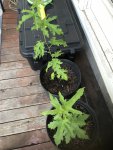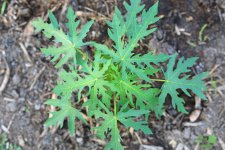I bought some seeds that were advertised as Paulownia tomentosa (Princess Tree) but are obviously not. The seeds did look like the real thing, but this is what has grown. I cannot determine what it is - possibly pin oak? There were no large seeds in the commercial soil I used for potting though that I know of. Any idea?
You are using an out of date browser. It may not display this or other websites correctly.
You should upgrade or use an alternative browser.
You should upgrade or use an alternative browser.
Not Princess Tree
- Thread starter Clay G
- Start date
- Joined
- Apr 14, 2015
- Messages
- 3,674
- Reaction score
- 2,997
- Location
- Inverness-shire, Scotland
- Hardiness Zone
- 8a
- Country

Welcome Clay G.  They do look similar to a pin oak but I can't be sure. Could you provide us with a close up of a leaf or two please?
They do look similar to a pin oak but I can't be sure. Could you provide us with a close up of a leaf or two please?
Greetings, welcome to the Forums.
I'm not entirely certain, but the leaves do resemble some forms of Sunset Musk-mallow (Abelmoschus manihot), also known as Aibika.
This member of the Mallow Family (Malvaceae) is native to southern and southeastern Asia, China, Philippines, Malesia, New Guinea, and Queensland, but is also widely grown as a leaf-vegetable, starch source, and ornamental plant.
The challenge here is that Ablemoschus manihot has amazing foliar diversity. There are many strains of this plant, many with remarkably different-looking leaves.
I'm not entirely certain, but the leaves do resemble some forms of Sunset Musk-mallow (Abelmoschus manihot), also known as Aibika.
This member of the Mallow Family (Malvaceae) is native to southern and southeastern Asia, China, Philippines, Malesia, New Guinea, and Queensland, but is also widely grown as a leaf-vegetable, starch source, and ornamental plant.
The challenge here is that Ablemoschus manihot has amazing foliar diversity. There are many strains of this plant, many with remarkably different-looking leaves.
That's an idea, but the leaves of Papaya (Carica papaya) usually have larger, coarser secondary lobes. Of course there may be variation in that species as well.Clay G Yours looks more like a Papaya seedling...
Here is a photo of another related Musk-mallow species, Abelmoschus moschatus, that shows somewhat similar leaves to the OP.
The leaf variation in Abelmoschus is confusingly complex. You have to look at many plants to see how wide the variation is.
Okra (Abelmoschus esculentus) is another close relative that should be considered.
I'm not 100% certain though, when leaves are as variable as those of Abelmoschus, there is always the possibility of a doppelganger.
Ask a Question
Want to reply to this thread or ask your own question?
You'll need to choose a username for the site, which only take a couple of moments. After that, you can post your question and our members will help you out.
Similar Threads
Forum statistics
Latest Threads
-
Preparing flower beds?
- Started by JMBrowning
-
Must have been mislabeled
- Started by Texas001
-
Selling sites for carnivorous plants
- Started by texc16195
-
Knock Out Roses Changing Colors
- Started by Harveyshot
-
Mushrooms
- Started by big rockpile
-
Herb Bed
- Started by big rockpile
-
Go All The Way
- Started by big rockpile
-
Im being attacked left, right, and center!
- Started by JittyJohnser
-
If This Passes What Are The Farmers Going To Do?
- Started by big rockpile
-
How to overwinter mint in pot
- Started by texc16195



